Thinking about using Partnered Projects and wondering if they’re worth it? I’ll give you the short answer first:
Based on my personal experience running a campaign, Partnered Projects is a legit, effective means of driving streams and engagement on Spotify.
Our campaign, which I received as a free trial worth $189, drove about 10,275 streams from two highly active, healthy playlists. At a cost-per-stream level that comes out to around $0.02, which is about as good as you can expect from a Spotify promotion (I’ve run dozens of them with a bunch of different companies). And again, those were streams from real people, not bots.
Pretty impressive – which is why they’re currently my top recommendation for playlist pitching.
Of course, playlisting campaigns aren’t some magic bullet for building a fanbase and getting your music heard. Playlisting streams, in general, aren’t incredibly targeted or engaged, because people often use playlists as background music. But, to be honest, Partnered Projects was able to drive higher-fit playlists and better engagement than I’d expected.
I’m going to break everything down below in more detail. If you’re interested in the nuts and bolts, keep reading. If you want to cut to the chase and start a campaign…
You can give Partnered Projects a try here.
Heads-up that that’s an affiliate link, because, yes, I do think these guys are legit. And with all of that said – let’s get into it.
The background on my campaign with Partnered Projects
I’ve recounted this in a bunch of other places, but the TL;DR version of the story is that, in the spring of 2023, I tested a bunch of different Spotify promotion services. Partnered Projects was part of that experiment, and they stacked up really favorably. You can read my breakdown of the whole thing here.
I actually hadn’t heard of Partnered Projects until I had a conversation with Andrew Southworth; he mentioned that he’d been working with the group to offer direct ad campaigns in tandem with their playlisting services. (This, by the way, is my recommended method for Spotify promotion – running ads and playlisting in tandem, because you get both cost-efficient streams and high engagement numbers. If you’re interested in doing this yourself, I’ve got a course on both methods here.)
I’ve got a very high opinion of Andrew, so I immediately added Partnered Projects to my list of companies to test. And then, in April of 2023, I sent them a track to try a campaign.
They didn’t take it.
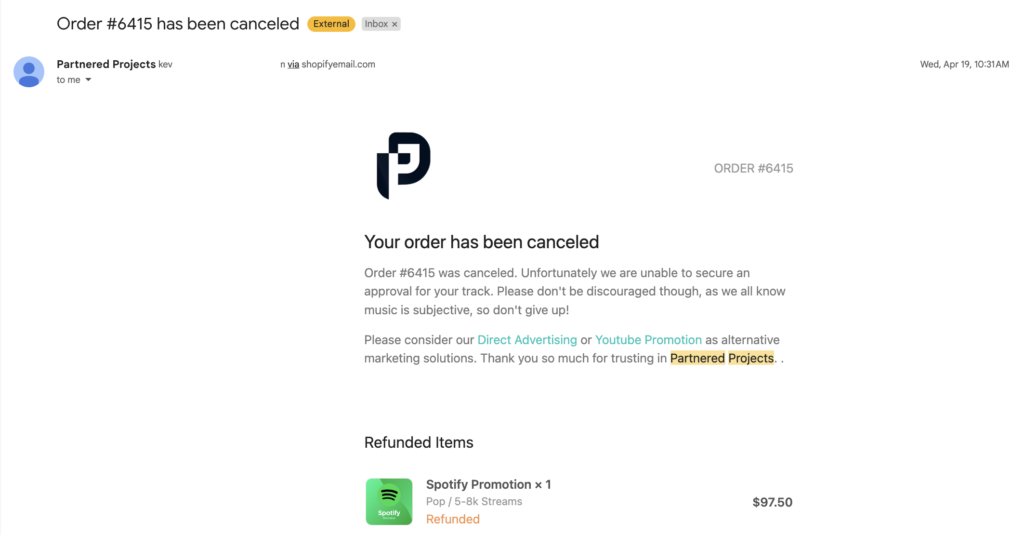
The nerve!
In seriousness, I actually really like that they do this: They don’t take your payment until they’re sure that they can work with your song. That’s a nice guarantee that you won’t be wasting your spend, and it’s a good balance against the scams out there that will take your payment and then will do nothing.

That said, I was kind of surprised that Partnered Projects couldn’t place the first song I sent them. It’s a well-produced, straightforward-pop track that I’m certain nearly every other promo company I’ve worked with would have run with. I suppose it’s a signal that they (and presumably their curators) are selective.
I was actually going to abandon trying the company at all, but about a week after my campaign was declined, Dalton Piche, the founder of the company, reached out to me personally and asked me to send another track over.

I ended up sending another song from the same artist, and Dalton was kind enough to offer me a free trial of what would’ve been a $189 campaign guaranteeing 10-15k streams. He mentioned that I could send the track through to him directly, but I opted to purchase the campaign on the website so that I’d have the “normal” experience.

And with that, we were off.
The process of working with Partnered Projects
Here’s the track we ended up going with:
Again, it’s a fairly straightforward genre-wise pop song, with a bunch of energy and relatable lyrics. Personally, I think the production and vocals are top-tier, and I also think that this mainstream type of music is the kind of stuff that playlisting campaigns can do really well with.
Once the track was accepted, there really wasn’t much for us to do; Partnered Projects set to pitching it and getting it placed.
I got an email immediately after the campaign started, confirming that the song had been accepted:
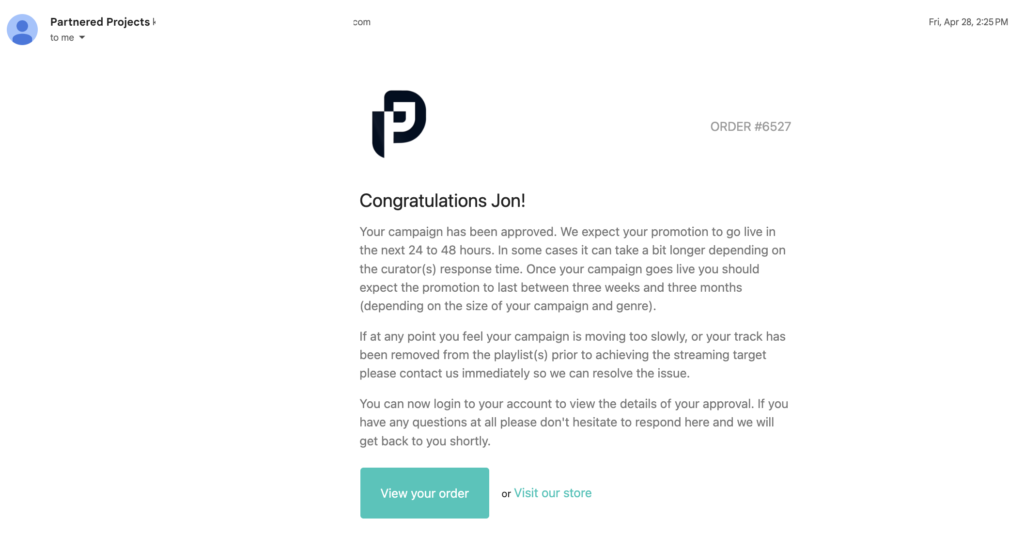
And that was about it. I wasn’t specifically notified when we were placed on individual playlists.
Relatedly, Partnered Projects has a portal where you can track the progress of your campaign, but for some reason when I submitted my order, my account wasn’t properly created.


Dalton set me up manually with access to the customer portal, which, as he noted, was having some display issues. Here’s what my campaign looked like in the backend:
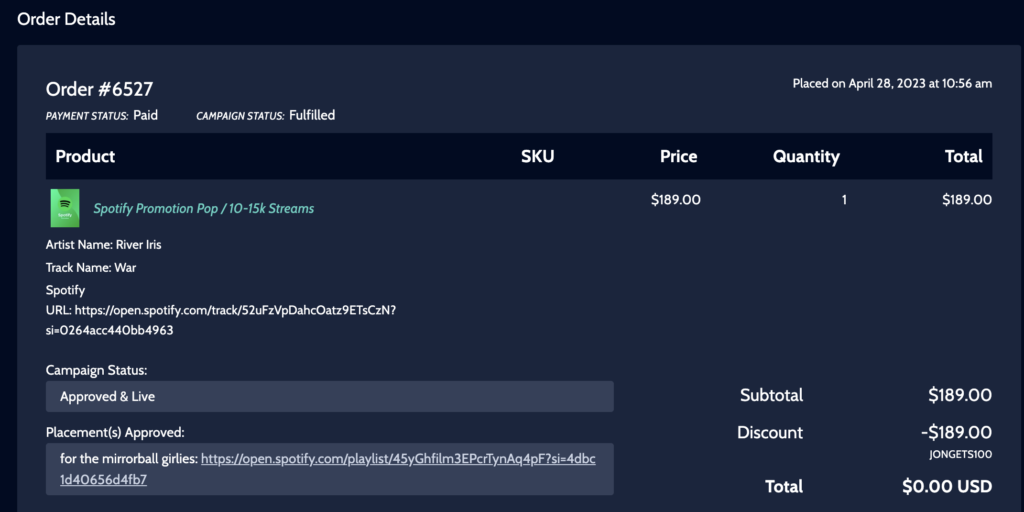
The weird thing was that the “Placement(s) Approved” section, where I’d hoped to be able to see all of the placements, only showed one playlist, and the title of the playlist didn’t match the Spotify link.
I got the gist of it, anyway; both the playlist called “for the mirrorball girlies” and the Spotify linked playlist were showing up in our Spotify for Artists, so I knew the two lists were the placements we’d gotten. But as you can probably tell from the sentence I just wrote, the experience of figuring that out was a little confusing.
On the bright side, while Dalton told me to expect the campaign to last three to four weeks, we ended up staying on those playlists for about a month and a half. That’s longer than most campaigns last, and it resulted in an impressive number of streams.
With that said, let’s get into the data next.
The results of the Spotify promotion
As I mentioned at the top of this article, I’d consider this to be a successful, legitimate Spotify promotion. The raw numbers are pretty good: For a value of $189, we were placed on two playlists that drove over 10,000 streams.
Those two playlists were:
Both are healthy and engaged. Here’s what their respective growth curves look like:

That’s exactly what you’d like to see from naturally-grown playlists – smooth upward growth curves with no sketchy spikes. And on the backend, things looked good, too. Here’s what things looked like in Spotify for Artists:
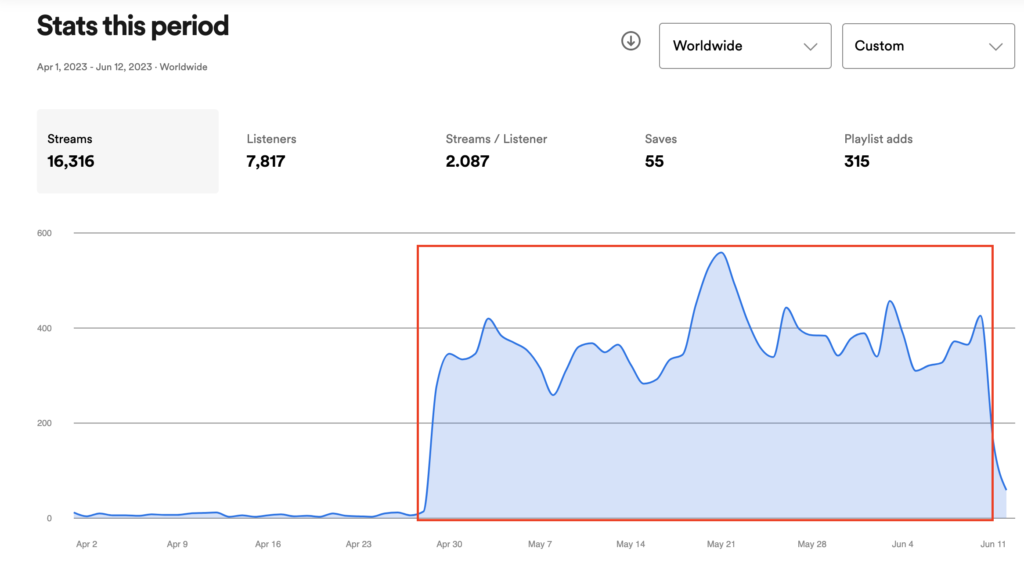
The red box represents where the campaign was active.
A few things to point out here.
First, the Streams / Listener ratio over the course of the promotion was really solid for a playlisting campaign. As I said at the top of this review, playlisting streams tend to be less engaged; usually, you’ll see a Streams / Listener ratio between one and two. For the duration of the campaign, we were above two streams per listener, which means that the average listener was streaming the track multiple times.
That’s great.
Also, you’ll note that there were 315 playlist adds over the course of this interval (almost all of which came during the campaign’s activity). That, too, is pretty solid. It’s made even better by the fact that many of the playlists to which the track was added drew a fair number of streams themselves.
Here are the top playlists over the past 28 days:
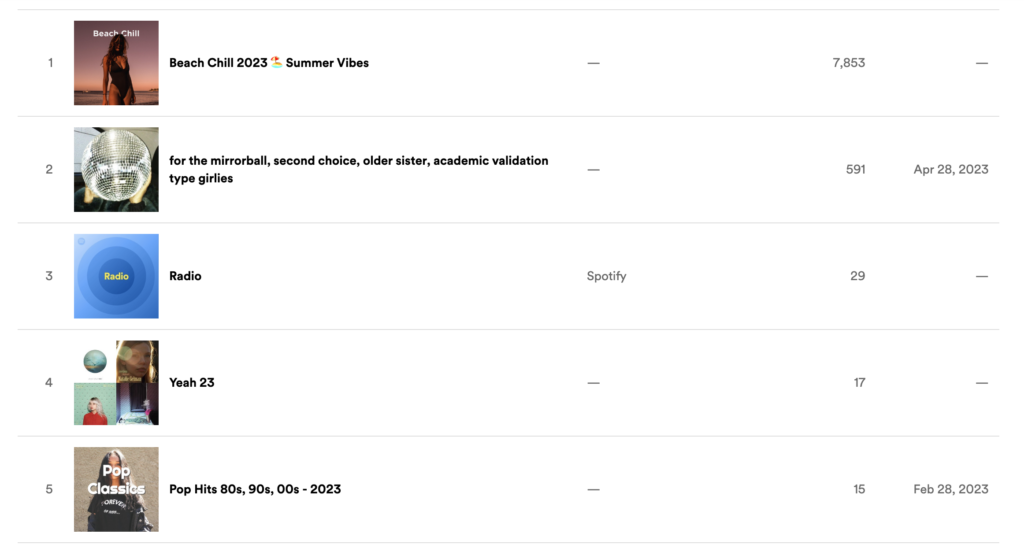
That Pop Hits list in fifth place actually drove about 1,000 streams for the track – it’s not one of Partnered Project’s placements, although it does have over 1,200 followers. There are a few other playlists that performed similarly, but the two for which our campaign claimed credit drove the most streams by far.
Also worth noting is that the top location for all of those streams was the United States. In itself, that fact is not a sign that the streams were legit (I’ve seen bot farms that mimic US streams). But given that everything else looks healthy, it’s a nice bonus that the listens were coming from the artist’s home country.
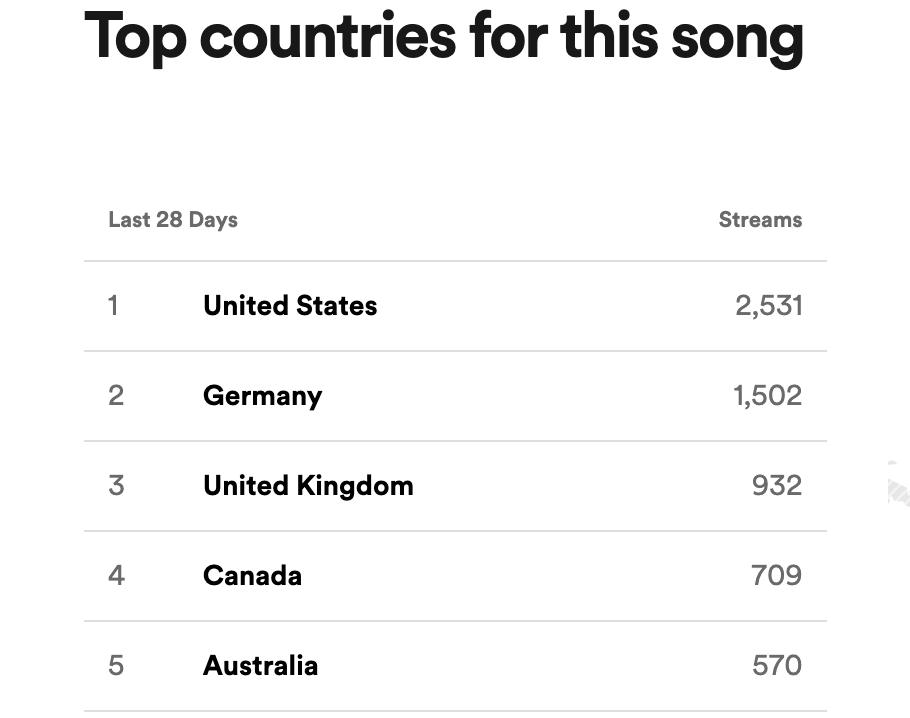
Up to this point, I’d count everything I’ve shared as a positive. Don’t think that I’m being selective or trying to overhype things – really, this campaign was very positive. There’s really only one area where I was disappointed in the data: The Source of streams side of things.
Basically, despite the solid engagement metrics, we’ve gotten very little algorithmic traction with the song so far.
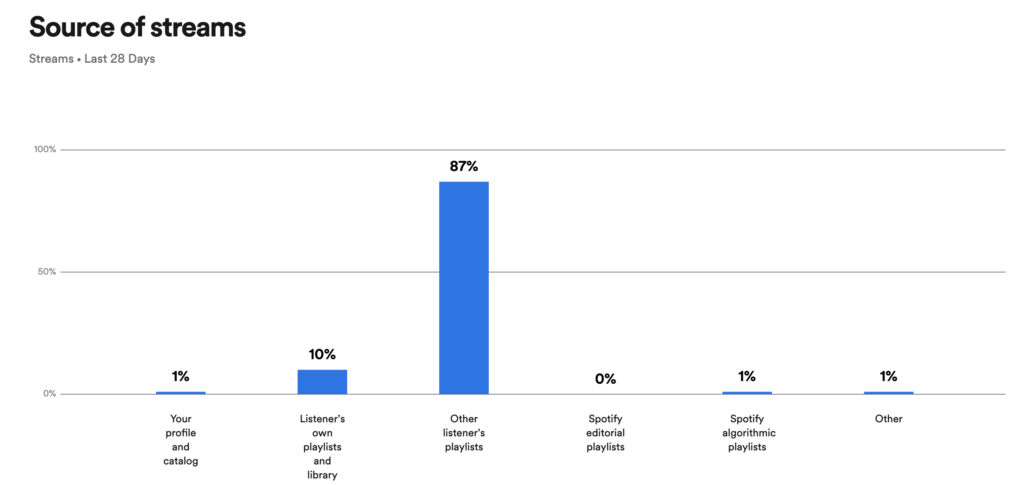
As that image makes clear, the vast majority of the song’s streams are coming from those independently operated playlists. Only 1% of streams are coming from algorithmic playlists (and those are almost entirely due to radio). This distribution means that, when our song is taken off of the third-party playlists, the streaming numbers are almost certainly going to dip way back down.
To be fair, this isn’t something that Partnered Projects can directly impact. The song we promoted has been out for several years, and it’s totally possible that a) the previous data has skewed things or b) Spotify just isn’t as interested in unearthing an older track for users. But also, I’ve almost always seen more than 29 Radio streams in a month after getting 10,000+ streams from playlists. Bottom line is that the algorithmic percentage is low, so I wanted to note it.
An overall analysis of Partnered Projects
Now that you’ve seen the data (or now that you’ve skimmed down to this bit of the article – which, if that’s the case, I totally respect), I’ll do my best to summarize what I see as the pros and cons of Partnered Projects.
Let’s start with the good stuff.
The pros of Partnered Projects
- They offer affordable entry-level pricing. Granted, I got a free trial, but the fact that they have packages starting at around $50 is appealing if you’re an up-and-coming artist who isn’t rolling in cash. (For comparison, Indie Music Academy starts around $300.)
- They seem to do very well at a cost-per-stream level. Their campaign drove the second-most-efficient results out of every company I’ve tested.
- They don’t take your money if they can’t work with your song. I’m a big fan of this; it helps you avoid sending money into the black hole of the internet.
- They have highly active, healthy playlists. As I’ve recounted above, the numbers for both the playlists we were placed on look great.
- Their placements were what I’d consider to be decent fits for the style and genre of our song. This was probably made easier by the fact that the song was a pop song – but still.
- Relatedly, our engagement metrics throughout the campaign were very solid.
- Their team has a bunch of experience. Partnered Projects is actually a sister company of Members Media, which runs campaigns for label acts. Dalton showed me some of the larger campaigns he was running (they were impressive) and explained that Partnered Projects is their offering for indies. It’s nice to have that kind of experience behind a promotion.
The cons of Partnered Projects
- It’s probably not fair to say this is a con with the company, but again, I was disappointed by the low algorithmic activity during and after the promotion. It’s likely due to external factors, since the engagement rates looked good, but I also feel like 1% of streams coming from algorithmic lists has to be a con.
- They’re pretty selective. Overall this is probably a good thing, but it’s a con for your chances of working with them. It’s also worth noting that you may have a harder time getting accepted if you aren’t in a mainstream-leaning genre.
- Their user experience wasn’t great. This is actually the biggest thing I think they could stand to improve. Submitting was easy enough, but once the song went through I had glitches getting into the portal. Then I had glitches seeing my placements. If I hadn’t been able to get quick responses from Dalton, I probably would’ve found this frustrating.
The overall verdict on Partnered Projects
Playlisting isn’t a magic bullet, but overall, Partnered Projects does it very well. They offer affordable entry-level prices, great cost-per-stream results, and solid engagement metrics from healthy lists. If you’re in a mainstream-ish genre and are looking to grow your Spotify presence, they’re worth looking at. Personally, I’d rank them in the top tier of companies in this space.
If you’re interested in trying a campaign with Partnered Project, here’s the link to give it a shot.
Whether you try playlisting or not, I hope this article was helpful as you think through your options – and I hope that, whether your next release gets 10 streams or 10 million, you work with the knowledge that your music matters.
Here’s wishing you good luck.

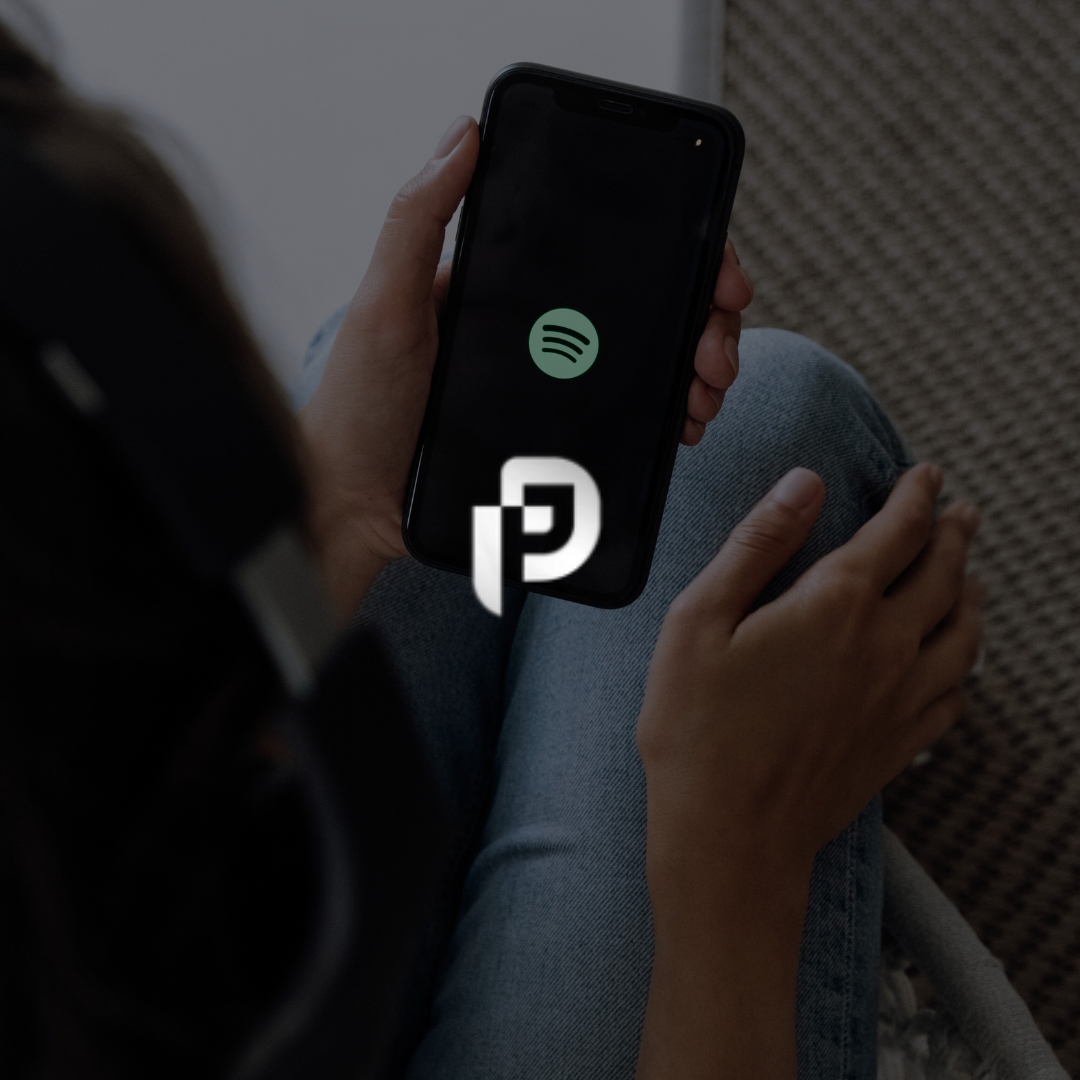







One Response
Hi Jon,
Thanks for your articles-very helpful. We have an debut single out. Have PR and have run several Playlist campaigns with varying success. Do you have an overall preference regarding country music. We really want to have to song targeted at our intended audience.
Cheers
Jase